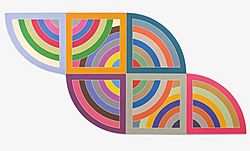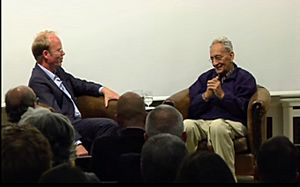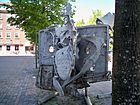Frank Stella facts for kids
Quick facts for kids
Frank Stella
|
|
|---|---|

Stella in 2012
|
|
| Born |
Frank Philip Stella
May 12, 1936 Malden, Massachusetts, U.S.
|
| Died | May 4, 2024 (aged 87) West Village, New York, U.S.
|
| Education | Princeton University |
| Known for |
|
| Movement | Modernism, minimal art, abstract expressionism, geometric abstraction, abstract illusionism, lyrical abstraction, hard-edge painting, shaped canvas painting, color field painting |
| Awards | 1984 Harvard University Charles Eliot Norton lectures National Medal of Arts |
Frank Philip Stella (born May 12, 1936 – died May 4, 2024) was an American artist. He was famous for his paintings, sculptures, and prints. Stella is known for his work in minimalism, which is an art style that uses very simple shapes and colors. He also worked in post-painterly abstraction, a style where artists move away from the emotional brushstrokes of earlier abstract art. Frank Stella lived and worked in New York City for most of his life.
Contents
Frank Stella's Early Life and Education
Frank Stella was born in Malden, Massachusetts. His parents were from Italy, and he was the oldest of three children. His father was a doctor, and his mother was an artist who painted landscapes.
When Stella was in high school at Phillips Academy, he learned to paint from his teacher, Patrick Morgan. Later, he went to Princeton University to study history. While there, he took art classes. His professors, Stephen Greene and William Seitz, showed him the art scene in New York City.
Stella's early art was influenced by abstract expressionism. This style uses colors and shapes to show feelings, not real objects. However, Stella became known for making abstract paintings that didn't try to show illusions or deep meanings. He wanted his art to be simply "what you see."
In the 1970s, he moved to a neighborhood called NoHo in Manhattan. Later, he lived in Greenwich Village and had a studio in Rock Tavern, New York.
Frank Stella's Art and Creations
Early Works: Simple Shapes and Colors
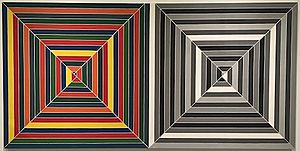
When Frank Stella moved to New York City, he started making art that focused on the painting itself as an object. He didn't want his art to be a window to another world.
In 1958-1959, Stella created his "Black Paintings" series. These paintings were different from what people expected. He used black house paint and a simple brush to make even black stripes on a bare canvas. He left thin strips of unpainted canvas between the stripes.
Stella famously said about his art, "What you see is what you see." This phrase became a popular saying for the minimalist art movement. It meant that his art was just what it looked like, without hidden meanings.
In 1961, Stella married Barbara Rose, who later became a famous art critic. He once said that a picture was "a flat surface with paint on it – nothing more." Later, in 1978, he married Harriet McGurk, a pediatrician.
In 1959, some of his paintings were shown in important art shows. One was at the Museum of Modern Art in New York. From 1960, Stella started using shaped canvases. These were canvases that weren't just a simple rectangle or square. They had unique shapes.
In 1967, he began his Protractor Series. These paintings featured arcs (parts of circles) inside square borders. He named them after circular cities he had visited in the Middle East.
Later Works: Adding Depth and New Materials
In 1967, Stella also designed the stage and costumes for a dance show called Scramble. The Museum of Modern Art in New York held a special show of Stella's work in 1970. He was the youngest artist to have such a big show there.
In the 1970s, Stella started adding depth to his paintings. He called this "maximalist" painting because it had more sculptural qualities. He began using wood and other materials in his art.
In 1976, the car company BMW asked Stella to paint a BMW 3.0 CSL car. This was part of the BMW Art Car Project. Stella said he started with the idea of racing car designs. He liked how the lines on a graph paper looked when painted onto the car's shape.
In 1969, Stella also designed a logo for the 100th birthday of The Metropolitan Museum of Art.
1980s and Beyond: Large Sculptures and Digital Art
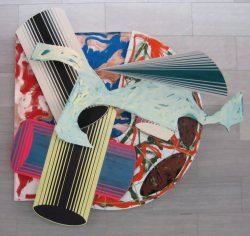

From the mid-1980s to the mid-1990s, Stella created many artworks inspired by the famous book Moby-Dick. He made small models or collages, which his assistants then made into large artworks.
In 1993, he designed all the decorations for the Princess of Wales Theatre in Toronto. This included a huge mural that was 10,000 square feet! In 1997, he oversaw the installation of another large artwork called Euphonia at the University of Houston. A large sculpture by him, Prinz Friedrich von Homburg, was placed outside the National Gallery of Art in Washington, D.C.
Stella also made a series of works called the Scaralatti Sonata Kirkpatrick series. He named these after the harpsichord music of Domenico Scarlatti.
Around 2010, Stella started using computers to create his art. He made stand-alone star-shaped sculptures. These stars were often one color, like black or beige, or made of metal. Their points could be solid, thin lines, or wire mesh. His sculpture Jasper’s Split Star (2017) was installed at 7 World Trade Center in 2021. In 2022, Stella even launched an NFT (a digital art token) that included files to 3D print his artworks.
Artists' Rights and Protecting Art
Frank Stella was also involved in protecting artists' rights. In 2008, he wrote an article about a proposed law in the U.S. called the "Orphan Works" law. This law would have made it easier for people to use copyrighted art if they couldn't find the artist.
Stella argued that this law would make it hard for painters and illustrators to earn money from their work. He believed it would be too easy for people to claim they couldn't find the artist, even if they hadn't looked hard enough.
Gallery of Works
-
Stella, Çatal Hüyük, 2008; location, Hallbergsplatsen, Borås
Exhibitions and Art Collections
Frank Stella's art was shown in many important exhibitions. These included "The Shaped Canvas" (1965) and "Systemic Painting" (1966) at the Solomon R. Guggenheim Museum. The Museum of Modern Art in New York held a second big show of his work in 1970.
In 2012, a large show covering Stella's whole career was held at the Kunstmuseum Wolfsburg in Germany. His work Protractor Variation I (1969) is also part of the collection at the Pérez Art Museum Miami.
Stella's art can be found in many famous museums around the world. Some of these include the Menil Collection in Houston, the National Gallery of Art in Washington, D.C., and the Whitney Museum of American Art in New York.
Awards and Recognition
Frank Stella received many honors for his art. In 1984, he gave a series of important lectures at Harvard University. These talks were later published as a book called Working Space. In this book, he talked about how abstract art could be made new again.
In 2009, President Barack Obama gave Frank Stella the National Medal of Arts. This is one of the highest honors for artists in the United States. In 2011, he received the Lifetime Achievement Award in Contemporary Sculpture. He also received an honorary doctorate from the University of Jena in Germany in 1996.
Personal Life
From 1961 to 1969, Frank Stella was married to art historian Barbara Rose. They had two children, Rachel and Michael.
Frank Stella passed away on May 4, 2024, at his home in West Village, Manhattan. He was 87 years old.
See also
 In Spanish: Frank Stella para niños
In Spanish: Frank Stella para niños


